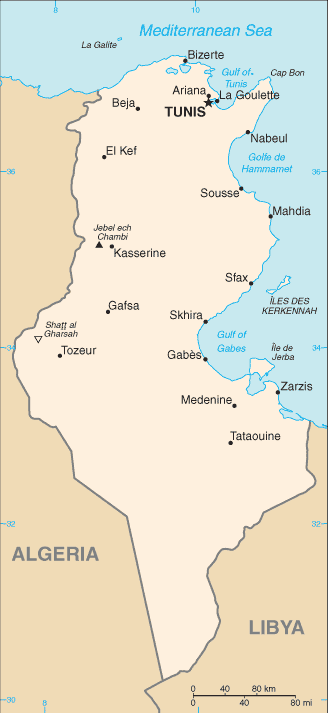Oct 17 2012
Topics Covered
Welcome to Tunisia
Overview of Resources
Industrial Minerals
Metals
Fossil Fuels
Investment
Sources
Welcome to Tunisia
Tunisia, with a total population of 10,732,900 as of July 2012, is located in Northern Africa, bordering the Mediterranean Sea, between Algeria and Libya. The country mostly has a temperate climate and covers a total area of 163,610 km2.
 |
The national flag of Tunisia.
Image Credit: CIA Factbook. |
Tunisia was recognized as an independent state by the French in 1956. The country still experiences high levels of poverty, unemployment, increasing food prices and corruption. Despite these challenges, the country has significant mining, agricultural, manufacturing and tourism sectors that contribute to a large extent to the country’s economy.
Phosphates and petroleum products are some of the country’s significant exports. The country’s GDP as of 2011 was $102.3 billion. The country’s immediate concern is to stabilize its economic status by drawing in more investments and control its current deficits.
Overview of Resources
Tunisia’s key natural resources include phosphates, petroleum, zinc, lead and iron ore. In 2010, the country was globally recognized as a significant producer of phosphate-based fertilizers and phosphate rock. In the same year, the country’s phosphate rock contribution to the world market was 4.3%.
In 2010, Tunisia was the world’s fifth leading producer of phosphate and in Africa it was the second leading phosphate producer. Other than phosphate, the country also produced cement, aluminum fluoride, refined petroleum products, gypsum, crude oil and common clay.
Industrial Minerals
In 2010, Tunisia produced cement amounting to about 10 million Mt/yr. Cement exports accounted for about 15% and 8Mt of cement was utilized domestically.
Compagnie des Phosphates de Gafsa (CPG) owned mines at Metlaoui, Jallabia, M’dhilla, Kef Eschfaier and Kef Eddour. Through these mines CPG produced 7.3 Mt of phosphate rock and exported phosphate rock amounting to 700,000 t in 2010.

The map of Tunisia. Image Credit: CIA Factbook
Metals
In 2010, Australia’s Celamin Holdings NL and Tunisian Mining Services S.A. collaborated to produce zinc and lead from four of Tunisia’s old mines. Through this project, the country aimed at producing zinc and lead between 2.5 million Mt and 3.0 Mt.
Iron ore in Tunisia was produced by El-Fouladh from the Tamera-Douaria and Jerissa mines.
Fossil Fuels
Natural gas and petroleum in Tunisia was explored and produced by 57 local and international companies that had 54 licenses to carry out exploration activities in Tunisia. In 2010, most of the country’s crude oil was obtained from the Oued Zar, the Adam, the Cheroug, the Baraka and the Ashtart oilfields.
Towards the close of 2010, Tunisia had 65 billion m3 of natural gas and 430 million barrels of crude oil. As far as new discoveries were concerned the country had one crude oil discovery and four natural gas discoveries in 2010.
In 2010, UK’s BG Group plc was a leading natural gas producer in Tunisia. This company controlled the Miskar field and increased the output of natural gas and condensates in 2010.
Investment
According to recent mining reports, the mining activities in Gafsa were at a standstill due to blockades and protests in this region. This resulted in non-production of phosphates for a week resulting in a steep decline in the production of processed phosphates.
Even in the midst of these protests, Tunisia’s beneficial investment laws and active involvement in the European markets has motivated the country to draw more foreign investments by increasing the production of phosphate rock, zinc, lead and hydrocarbons. The country expects to see an increase in its production of phosphate and phosphate fertilizers after the completion of the TIFERT and the Celamin Holdings projects.
Cement production is also expected to increase in the future due to increase in demand for construction materials and cement will also be exported to Libya and Algeria in large quantities. This increase in export will likely uplift the economic status of the country.
Tunisia’s economic growth rate is expected to speed up based on the government’s efforts to increase the mining activities in the country, attract international investments and increase the production and export of its mineral and mining commodities.
Disclaimer: The Author of this article does not imply any investment recommendation and some content is speculative in nature. The Author is not affiliated in any way with any companies mentioned and all statistical information is publically available.
Sources